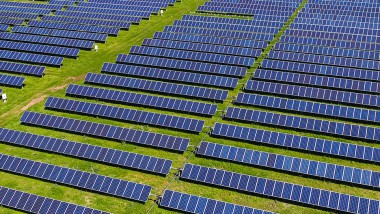Finance and Climate Change: A Split Coming Between Europe and the United States
While the Trump administration has pulled out from the COP 21 agreement, for French investors, in contrast, the effective date of Article 173 is a sort of starting signal.
Key Takeaways:
- Diverging positions between the U.S. and Europe on climate change
- French investors are well aware of the challenges of Article 173
- Our mission: offer relevant solutions and not mere window-dressing
Diverging positions between the US and Europe on climate change
A portion of the US economic power structure had publically and unsuccessfully called on Trump to honour the COP21 commitments, and some trends out of his control will continue to drive the development of renewable energies, which, in the US as elsewhere, are becoming more and more competitive each day, even without public subsidies. Solar panel prices have dropped by 75% in five years, thanks to technological advances1, and some states, like California, have set ambitious targets (in California’s case, for 50% of its power to come from renewable sources by 2030)2. American companies and households continue to invest in renewable energy and energy efficiency. But the plans made by the Trump administration in the name of defending jobs and fossil-fuel-intensive industries – its determination to restart the coal industry and to revive the controversial Keystone pipeline, which was halted by his predecessor – reflect its objective of keeping the heaviest polluting industries in the race. The US’s withdrawal from the Paris Agreement is at odds with the ongoing transition to a low-carbon economy and could widen the climate gap between the two sides of the Atlantic. Meanwhile, French institutional investors have shown real enthusiasm for Article 173 as a true area of investment and not a mere marketing gimmick. And keep in mind that some major French investors “jumped the gun”, reviewing their portfolios well before the law required them to do so. These include Ircantec and ERAFP, the French public sector supplementary retirement fund, which as early as 2005 had decided to invest 100% of its assets on the basis of SRI principles and since 2014 has published the carbon footprint of its equity portfolios.
Natixis AM on board with French institutional investors for sustainable investment
Obviously, institutional investors’ main challenge, and one made even more difficult during this period of low rates, is still to deliver adequate returns to their clients. As an asset manager, we must be able to demonstrate that sustainable is compatible with the quest for returns. And we have put our money where our mouth is. Since 2008, Natixis Asset Management has been a signatory of the United Nations’ Principles for Responsible Investment (UNPRI). And in October 2014, our Mirova subsidiary was one of the first financial institutions to take the “Montreal Pledge” (to publish the carbon footprint of its portfolios), alongside institutional investors such as ERAFP and FRR, the French public sector employees retirement fund.
Solutions exist for assessing and reducing carbon footprints
One of the strengths of our CSR policy is that it increasingly integrates extra-financial aspects into the management of all our portfolios, and, in coordination with our parent company, we have decided to reduce our exposure to the most “carbon intensive” sectors, including an exclusion of companies that are most heavily exposed to coal. But we must also avail our clients of solutions that fit their own needs. That’s what we’re doing through Mirova, our subsidiary dedicated exclusively to sustainable investment, with about 15 extra financial analysts. Decarbonisation of portfolios is not the only ESG challenge but it is no doubt the most urgent one now. Investing in green bonds is one of Mirova’s clearest responses, but over the past year and a half, our subsidiary has also embarked on carbon impact analytics, its method of calculating carbon footprints, developed in partnership with Carbone 4. This bottom-up review aims to identify each company’s total carbon footprint, including indirect emissions or those resulting from the use of the company’s products, something that is hard to assess properly. In addition to including the indirect impacts, carbon impact analytics seeks to estimate emissions that have been “prevented” by the use of green technologies. This method also allows managers to assess how to reduce their carbon footprint but also to focus on energy transition solutions. Here again, while the law provides more incentives than obligations and allows a wide margin for manoeuvre in the approach used, our constant concern is to achieve the greatest possible relevance, rather than mere window-dressing. This is a matter of responsibility not just with regard to the law, but also our clients’ beneficiaries.
For you – and for us – the effective date of Article 173 is the beginning of a long journey, and we fully intend to accompany you throughout that journey.
1 U.S. Department of Energy 2015; National Renewable Energy Laboratory 2016
2 NC Clean Energy Technology Center: DSIRE (Database of State Incentives for Renewables & Efficiency)
Published in May 2017, updated on 28 August 2017
Natixis Global Asset Management S.A.
RCS Paris 453 952 681
Capital: €178 251 690
21 quai d’Austerlitz, 75013 Paris
www.im.natixis.com
This communication is for information only and is intended for investment service providers or other Professional Clients. The analyses and opinions referenced herein represent the subjective views of the author as referenced unless stated otherwise and are subject to change. There can be no assurance that developments will transpire as may be forecasted in this material.
Copyright © 2017 Natixis Investment Managers S.A. – All rights reserved





 Mirova's Responsible Investment Report
Mirova's Responsible Investment Report
 The Greening of Corporate Culture
The Greening of Corporate Culture
 Green Bond Principles
Green Bond Principles
 The Real Impact of Carbon on Portfolios
The Real Impact of Carbon on Portfolios